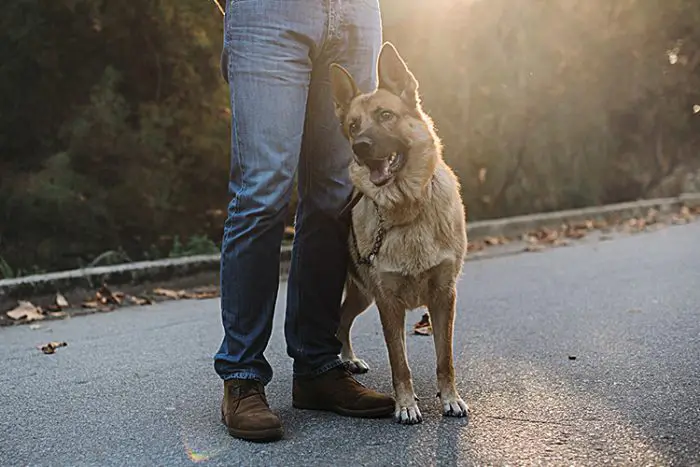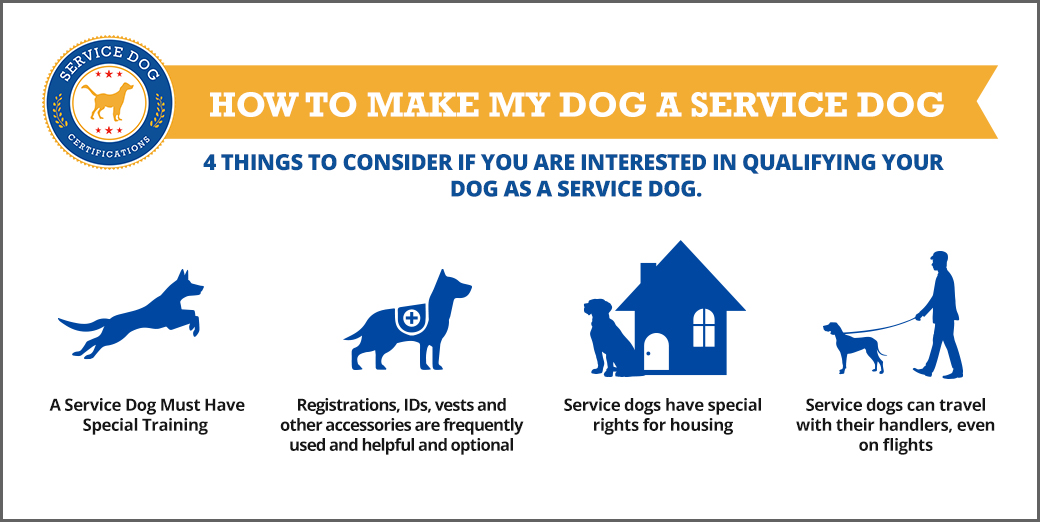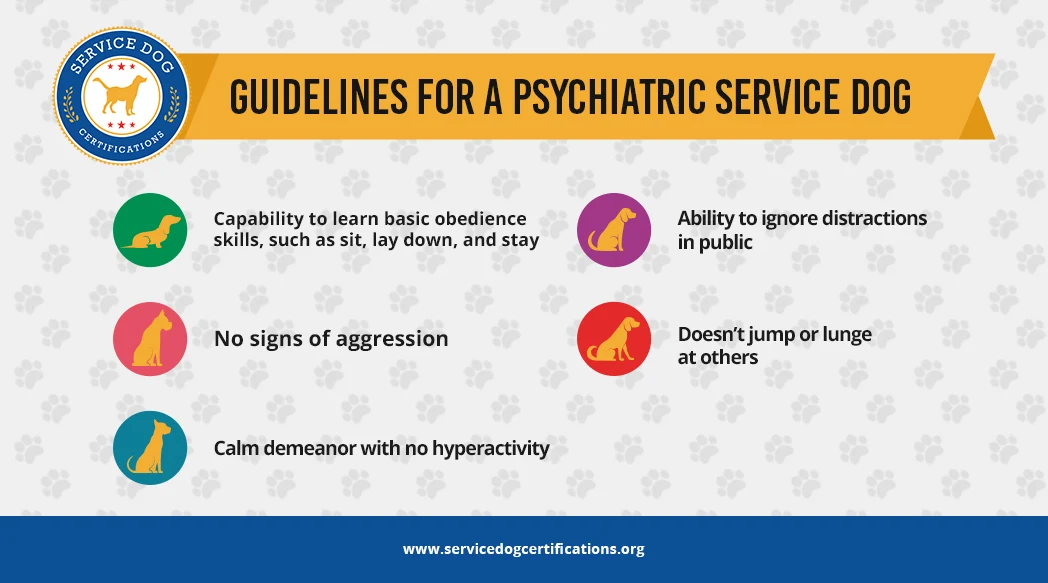How to Train a Psychiatric Service Dog

Do psychiatric service dogs need training? Yes, they do. But because psychiatric service dogs (PSD) often are confused with emotional animal support animals (ESA), people sometimes assume that PSD’s aren’t trained. While psychiatric service dogs help people with mental or emotional disorders, just like ESAs, they receive extensive training to learn vital skills that will enable them to assist their handlers with particular, often life-saving tasks. Read on to know what that entails and how to train a psychiatric service dog.
What Is a Psychiatric Service Dog?
Psychiatric service dogs, a specialized sub-category of service animals, are all trained in a variety of functions specifically for their handlers’ disabilities. In the case of psychiatric service dogs, they assist people with psychological or emotional disorders. For example, a psychiatric service dog who helps a child with autism might perform the following tasks:
- Flip on light switches before a child enters a room to reduce fears of the dark.
- Place his head against the child to provide comfort during an outburst.
- Bark for assistance is a child begins to self-harm or starts to wander away.
Unlike ESAs, psychiatric service dogs undergo months—sometimes years—of training to perform these tasks that keep their handler safe.
Training a Psychiatric Service Dog
Although psychiatric service dogs can receive training through outsourced professional trainers, a handler can choose to train a dog themselves. Training a service dog independently, though time-consuming, can reduce overall costs and create a stronger bond between the service dog and its handler. Here are a few basic steps on how psychiatric service dogs are trained:
1. Determine What Tasks Are Needed
Before starting on the journey of training a service dog, it’s important to assess what tasks are necessary to perform. A physician or a licensed mental health professional can determine if a psychiatric service dog is necessary and what tasks a handler might need to be accomplished. Once there’s an idea of what skills are required, finding the right service dog comes next.
2. Find the Right Dog
Most professional service dog organizations breed dogs for the right temperament and intelligence. Because a service dog’s job is critical to a person’s health, and the tasks are so demanding, not every dog can become a service dog.
No matter how excellent a dog’s training might be, they won’t succeed as a service dog if they don’t have the ideal temperament. When looking for a dog to train as a service dog, look for reputable breeders who specialize in service dogs. When choosing a dog, the following traits are an advantage:
- Social with people and other dogs
- Alert and attentive
- Does not startle
- Likes to be held
3. Encourage Socialization Skills
Once the right dog is found, it’s essential to socialize them with people and other animals. By exposing a dog to new environments prepares them to tolerate different scenarios. This means interacting with the dog extensively, taking the dog outside, and getting them comfortable in different surroundings. Dogs that are anxious or agitated, especially around new people and places, typically do not make good service dogs. Fostering a dog’s comfort levels in varying locations encourages the making of a successful service dog.
4. Begin Training for Basic Skills
Starting a dog on basic skills provides a good foundation for more in-depth tasks. These beginning commands also give the trainer a good idea of how well a dog takes direction. Basic obedience commands for a dog to follow include:
- Stay
- Heel
- Sit
- Come
- Drop
- Leave

5. Hone Public Access Skills
After a service dog-in-training understands basic obedience commands, it’s time to practice public access skills in random environments. These areas include parks, pet stores, outdoor restaurants, and other places to acclimate the dog to a broad range of external stimuli. Allowing a dog to get used to new surroundings helps keep a service dog calmer in the long run.
Because service dogs follow their handlers everywhere, it’s essential that a dog be well-behaved in public—for the sake of the public and the dog. Also, every service dog is a representative of service dogs everywhere. Service dogs are well-regarded because of their exemplary public access skills, and having a well-behaved service dog honors that tradition.
6. Individual Response Training
Once a service dog-in-training is ready to start their psychiatric task training, they already have their basic skills and public access fine-tuned. This way, they can utilize their public access and basic skills while using their individual response skills. Repetition and positive feedback help to make the process flow much more smoothly.
Of course, this stage of training depends entirely on the tasks required for the dog to fulfill. Here are a few examples of tasks:
- If the dog needs to obtain medication during a psychiatric emergency—like a panic attack—the dog can obtain a bag or pouch containing the medication. Ensure the bag is always easily recognizable and that the medication is kept in the same bag at all times.
- A dog can help a person during an autistic outburst in a case of sensory overload by performing reality affirmation tasks like nudging a person or patting a person’s leg during an attack. The dog must learn to recognize cues when such a situation occurs, depending on its handler’s needs.
- People with Post-Traumatic Stress Disorder (PTSD) may need help to leave an area that overwhelms them. Dogs can receive training to find and lead their handler to the nearest exit.
Progress of Training a Psychiatric Service Dogs
When working with any service dog-in-training, it helps to keep a training log. Training logs enable a trainer to review a dog’s progress and address any problem areas. These logs can also serve as proof that the psychiatric service dog has received training.
Just like other service dogs, psychiatric service dogs improve the longer they remain with their handler. Dogs are intuitive and enjoy repetition, making them natural ideal animals to work closely with humans. As “man’s best friend,” there’s no better animal than a dog to help someone through tough times. But it may take time and patience to fully train a psychiatric service dog to assist their handler at their best.
About the Author: The writing team at Service Dog Certifications is made up of folks who really know their stuff when it comes to disability laws and assistance animals. Many of our writers and editors have service dogs themselves and share insights from their own experiences. All of us have a passion for disability rights and animals.
3 comments
Leave a Reply Cancel reply
Latest Posts

Dangerous Materials Hiding in Your Dog Products
Jake’s German Shepherd began developing strange rashes around his collar. Three vet visits later, they figured out the leather was treated with chromium — a chemical that irritates sensitive skin. Jake had no idea his dog’s collar contained industrial chemicals. Most dog owners don’t know what goes into the products they buy. Many companies use […]

Read More

Can You Bring a Service Dog to a Basketball Game?
Yes, you absolutely can bring your service dog to basketball games. Whether you’re heading to your local high school tournament, a packed college rivalry game, or splurging on NBA tickets, the Americans with Disabilities Act protects your right to be accompanied by your service dog anywhere the public can go. When you arrive, venue employees […]

Read More

Best Pet Health Insurance Providers
If you own a pet, you know how important — and expensive — vet care can be. One way to offset those costs is to purchase pet health insurance. Like typical health insurance, pet insurance is available at many price points, and can cover all, most, or only some of your vet-related costs. It can […]

Read More




Great information, thank you. I have a older puppy I want to train myself for psychiatric reasons also anxiety. She is 4 / 1/2 months old. I realy need this to work so I appreciate all your advice.
Very helpful information! I am looking to getting a puppy with hopes to have him trained as a Legally Certified Psychiatric Service Dog. Thank you!
I am looking for a small service dig or one that is calm and I can train. I had a service dog who was 13 and was very calm
I develop PTSD when I got mugged and suffered from anxiety.,My precious Sophie kept me calm. Sadly she passed in January at 17 from kidney failure. She still visits me from heaven. I have captured her ghost standing on my bed and orbs flying into and out of her bed.
She was my rock when we were living in my car for 8 months.